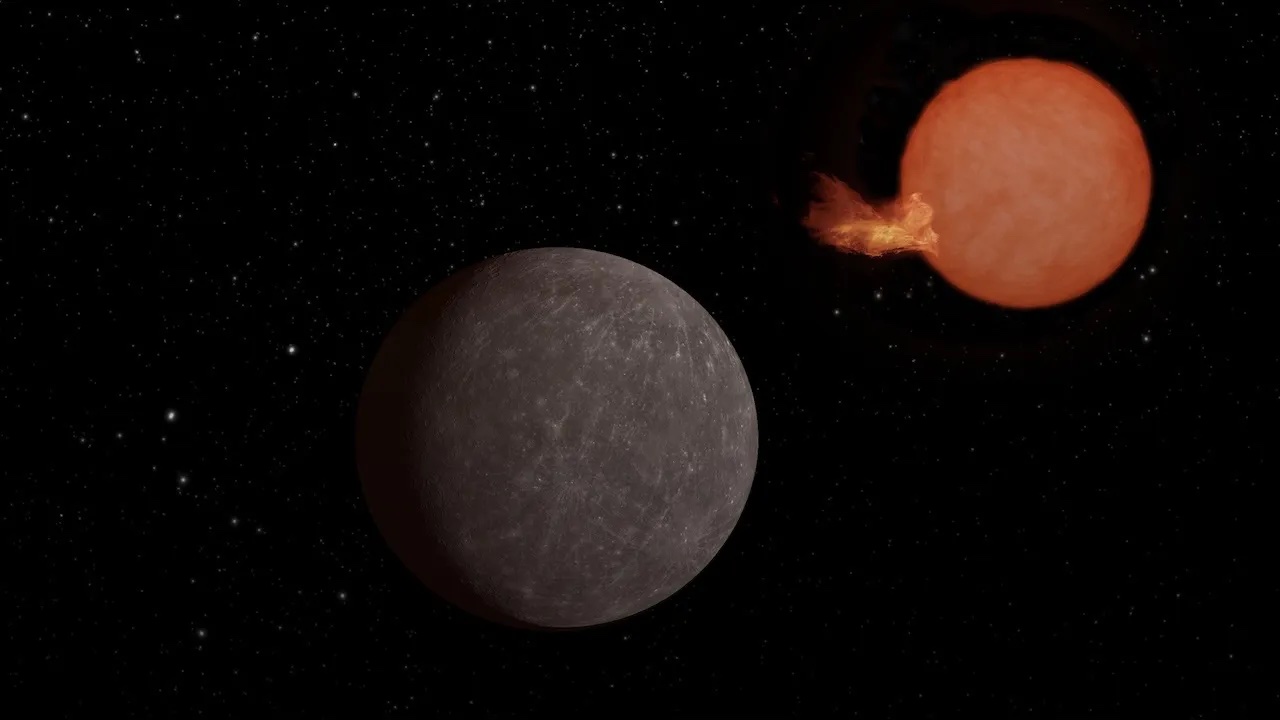
Astronomers have discovered an Earth-size planet that is showered with so much radiation, its atmosphere eroded away long ago, leaving it bare. Life as we know it can't exist on this blistering world, but astronomers are interested in it for another reason: For the first time, they may be able to study the geology of a planet outside our solar system.
The newfound exoplanet, named SPECULOOS-3 b, is a rocky planet roughly 55 light-years from Earth. It zips around its host star every 17 hours, but days and nights on the planet are endless. Astronomers suspect the planet is tidally locked to its star, like the moon is to Earth. A single dayside always faces the star, while the nightside is locked in eternal darkness.
Telescope observations show that frequent radiation from the exoplanet's star, a 7 billion-year-old red dwarf about the size of Jupiter, roasts the planet to Venus-like temperatures. So any atmosphere the planet may have had easily escaped into space long ago and left behind an airless, sizzling ball of rock, astronomers reported in the new study, published May 15 in the journal Nature Astronomy.
"Life as we know it could not emerge on the surface of the planet — atmosphere or not — because it could not sustain large amounts of water in liquid form," study lead author Michaël Gillon, an astronomer at the University of Liège in Belgium, told Live Science. "It is a bare rock planet like Mercury."
Related: James Webb telescope detects 1-of-a-kind atmosphere around 'Hell Planet' in distant star system
Although SPECULOOS-3 b isn't friendly toward life, the astronomers said it is close enough to Earth for detailed follow-up studies of its chemical makeup, which would reveal whether the planet was ever geologically active. Observations already planned with the James Webb Space Telescope (JWST), for instance, will be able to confirm if volcanoes erupted on the planet. That would reveal how rocky planets like SPECULOOS-3 b form around faint, lightweight stars and if some of them could be favorable to life despite being close to their stars.
The researchers "searched intensively" for planetary siblings of SPECULOOS-3 b in the same star system but did not find any, Gillon said. He noted that those additional planets may exist but are simply too small or too far out from their host star to be seen.

A hot planet around a cool star
Gillon and his colleagues discovered SPECULOOS-3 b using a network of six telescopes spread across Chile, the Canary Islands and Mexico since 2011. That network is called the Search for Planets Eclipsing Ultra-Cool Stars, or SPECULOOS, which shares its name with a Belgian spiced shortbread traditionally given to children every Dec. 6 for St. Nicholas Day.
The project's main goal is to detect rocky planets orbiting ultracool dwarf stars, whose tiny size makes it easier for telescopes to detect orbiting planets. In addition to being thousands of degrees cooler than the sun and hundreds of times dimmer, they burn through their fuel slowly and end up living far longer — around 100 billion years. (The sun will be roughly 10 billion years old when it dies about 4.5 billion years from now.)
"They are expected to be the last stars still shining in the universe," study co-author Amaury Triaud, a professor of exoplanetology at the University of Birmingham in England, said in a statement. Their extra-long lifespans offer favorable windows for life to emerge on planets within their systems, the researchers say.
However, their extreme faintness makes them difficult to study. To discover SPECULOOS-3 b, a SPECULOOS robotic telescope in Mexico observed telltale dips in the host star's light continuously for five nights in 2021. The first hints of the orbiting newfound planet emerged then and were confirmed a year later, according to the study.
"If there's no atmosphere, there would be no blue sky or clouds — it would just be dark, like on the surface of the moon,"" study co-author Benjamin Rackham, a research scientist at MIT, said in a separate statement from MIT. "And the ‘sun' would be a big, purplish-red, spotted, and flaring star that would look about 18 times as big as the sun looks to us in the sky."
SPECULOOS-3 b is the ninth such planet found by the project, and the team expects to detect many more in the coming years, Gillon said. Like the planets previously discovered by the project — including a family of seven in the well-known TRAPPIST-1 system, some of which are considered potentially habitable — the newfound SPECULOOS-3 b "is an excellent target for JWST," Gillon said .
"With this world, we could basically start doing exoplanetary geology," study co-author Julien de Wit, an assistant professor of planetary sciences at MIT, said in the MIT statement. "How cool is that?"







